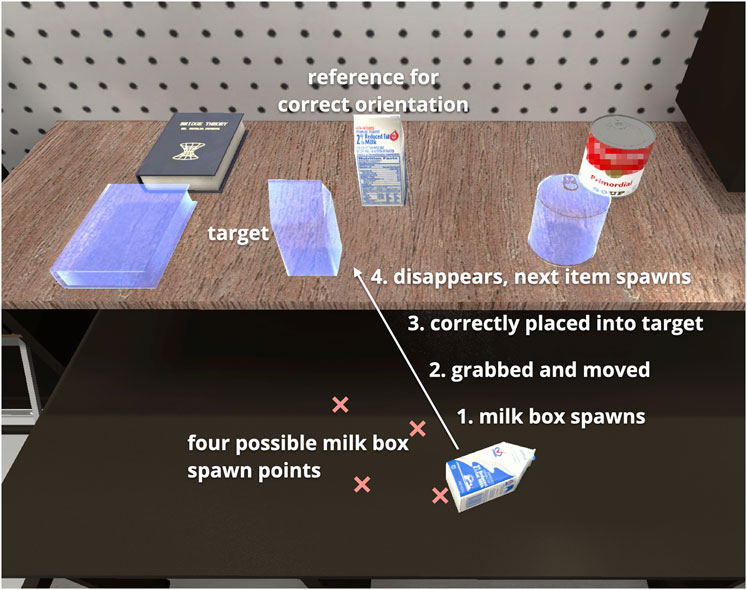Steady Hands in the Virtual World

Figure 1: The steps of moving an item to its target in task B.
Introduction
Virtual reality (VR) has opened up new horizons in digital interaction, allowing users to engage with virtual environments in ways that were once the realm of science fiction. However, despite the advancements, one area that remains a challenge is the replication of the nuanced dexterity of human hands within these virtual spaces. This study delves into the intricacies of manual dexterity in VR, focusing on how different grips affect our ability to manipulate virtual objects. The research is pivotal for applications where precise hand movements are crucial, such as medical simulations, engineering design, and remote operation of machinery.
Methodology
The study gathered 21 participants from a university campus using emails, leaflets, and word-of-mouth. These volunteers, ranging in age from 15 to 61, were introduced to the virtual reality (VR) equipment, which included a headset and a special glove that provides force feedback. This glove was a key part of the experiment as it allowed participants to ‘feel’ the virtual objects they were interacting with. Most of the participants were new to VR, ensuring that their experiences were not influenced by prior familiarity with such technology.
Once the participants were comfortable with the VR setup, they were tasked with two types of object manipulation activities in VR. The first task involved moving six cans to a target location with precision, while the second task required them to move a variety of objects, like cans, books, and milk cartons, from different starting points to a set target. The order in which the participants interacted with the objects was randomised to ensure fairness. After completing the tasks, they filled out questionnaires that measured their sense of presence in the VR environment and their perceived performance. The entire process was designed to be as intuitive as possible, with in-VR instructions guiding the participants through each step.
In these tasks, the researchers were looking at how well the participants could manipulate objects in VR using the glove, comparing their performance with a fixed grip versus a variable grip. The data from these activities were then carefully analysed to understand the impact of grip type on task performance in VR.
Key Findings
The study revealed that when participants used a fixed grip—where their virtual hand’s grip on an object didn’t change—they were more precise in placing objects at a target location. Specifically, objects were placed with an average of 1 millimetre closer to the target’s centre compared to when a variable grip was used. This might seem like a tiny difference, but in the world of VR, where precision is key, it’s a significant finding. Moreover, the orientation of the objects was more accurate; imagine trying to get a key into a lock, where even a small misalignment can mean the difference between success and failure.
Transitioning to efficiency, the study found that tasks were completed quicker with a fixed grip. This suggests that when the grip is constant, people can focus more on the task rather than adjusting their hold on the object. Additionally, the study measured how demanding the task felt to participants, which is important because if a VR experience is too demanding, it could lead to frustration and a poor overall experience. The results indicated that a variable grip, where the participant’s grip on the object changed, was perceived as more demanding and, consequently, more frustrating. This insight is crucial for VR developers aiming to create user-friendly experiences, especially in training simulations where learning efficiently and without frustration is key.
Discussion
The discussion also pointed towards potential improvements and future research directions. It acknowledged the need for dynamic adaptation of the virtual grip to better mimic the natural movements of the hand. This adaptation would require the system to respond to the changing contact points between the fingers and the object as it moves within the hand. The study’s findings serve as a stepping stone for further research, suggesting that enhancing the system’s responsiveness to finger positioning and pressure could lead to more intuitive and efficient VR interactions. Moreover, the discussion emphasized the importance of continued exploration in the field to overcome the current limitations and to develop VR systems that can faithfully replicate the nuanced aspects of manual dexterity.
Conclusions
The research looked at how people use their hands in VR and found that keeping a grip steady is better than changing it. Even though changing your grip sounds cool and realistic, it actually makes it harder to do things right in VR. The study tells us that VR systems need to get better at copying the small movements our hands make. This work helps people who make VR to understand what they need to improve, so using your hands in VR can feel as real as in the real world.